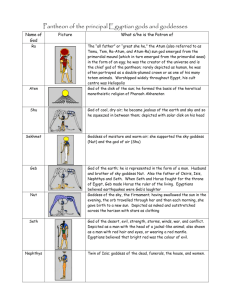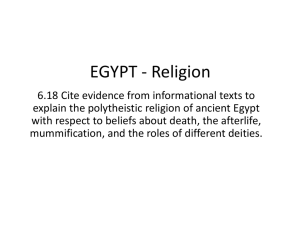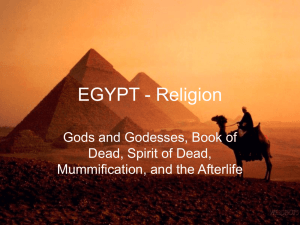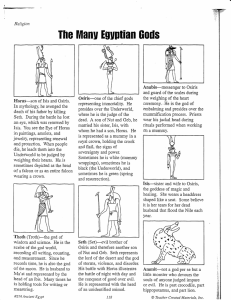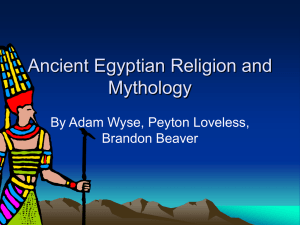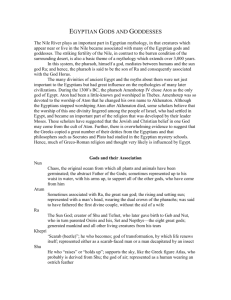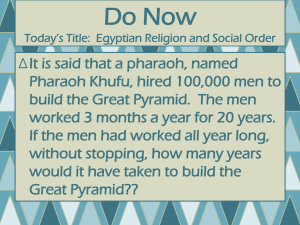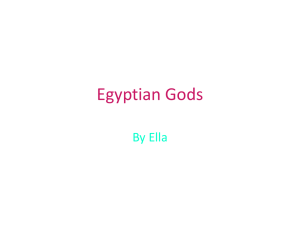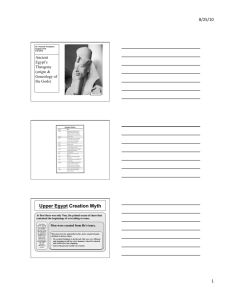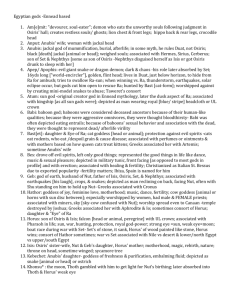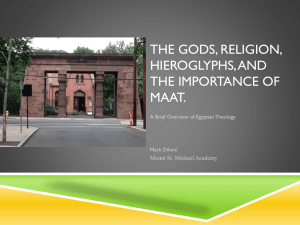Religion in Ancient Egypt
advertisement
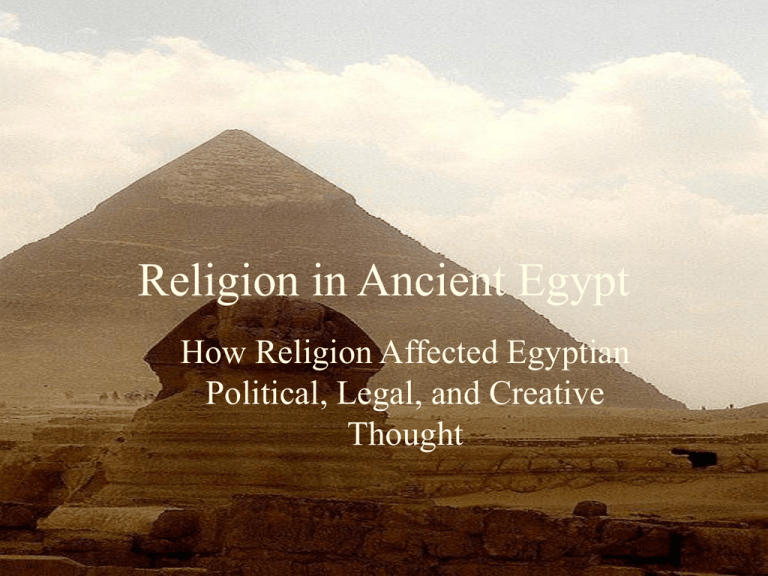
Religion in Ancient Egypt How Religion Affected Egyptian Political, Legal, and Creative Thought Impact of Geography on Religion: The Nile • Rose and the land was covered with water; the Nile subsided and land, now full of life was ready to be sewn and produce crops • Consequently, Egyptians accepted water as the beginning of everything • Water revered in the form of a creator-god named Atum, who emerged from the first hill that rose from the water • Atum was “the perfect one” that created the earth and sky, who later had children Impact of Geography on Religion: Climate • From the Old Stone Age man had buried the dead, and early Egyptians did too • Hot, dry climate meant that body did not rot, but desiccated and remained a wholly recognizable corpse • Consequently developed unparalleled emphasis on continued existence of physical body after death • Sun also recognized as another great lifegiving force (hence Sun-god Re) The Development of Deities • Atum ejected from his being Shu (air) and Tefenet (moisture) (the sun itself) • Atum also known as Ra • Separated sky (Nut) from the earth (Geb) • Geb and Nut had children: the gods Osiris, Isis, Seth, and Nephthys • Anubus born out of love between Nephthys and Osiris—helped Isis by embalming king’s body • Local gods, such as Amon (Thebes) began to emerge during Middle Kingdom Nut (goddess of the sky and heavens) is depicted with her husband-brother Geb. Together they bore 5 children (Osiris, Horus the Elder, Seth, Isis, and Nephthys The Depiction of Deities: Atum • Atum is rarely depicted as a human, but rather as a crown or as one of his many totem animals (i.e. a black bull, cobra) • Not only the father of the gods, but also the father of the pharaohs Atum, wearing the double crown, worshipped by the deceased Lady Tashenat; Third Intermediate Period; in the Louvre Religious Beliefs • Aside from their physical body, each person had a ka, ba, and akh • Ka is a person’s spiritual duplicate, which was stored in the heart and separated from the body at death • Ba is essentially the person’s character or personality; left the body at death; depicted as a human-headed bird • Akh is the form the person would exist in in the afterlife (through spells said over the mummy) Religion and Political Thought • Concept of the god-king was central • Pharaoh believed to be the earthly embodiment of the god Horus (son of AmonRe) • Partial divinity of king helped to ensure stability since the word of the king would be considered the word of the gods • The Pharaoh owned all of the land in Egypt, the people, and their possessions Religion and Legal Thought • Believed law was infused into the world by the gods at the time of creation • Goddess Ma’at personified law (truth, righteousness, and justice) • Despite absolute power, the king must rule over Egypt subject to Ma’at • Goal was to maintain equilibrium • According to Ma’at, the goal of all people was to maintain the correct balance of the universe Depiction of Ma’at • Ma’at is personification of law, justice, order, and truth • Depicted as a young woman sitting or standing • Held scepter in one hand and ankh in other • Sometimes has wings or ostrich feather Religion and Legal Thought • Likely because of Ma’at, Egyptians generally law abiding, stability-seeking people • Unlike the Mesopotamians, Egyptians did not have a codified body of laws • Legal system was based on precedent • Courts ensured that laws were consistent Ma’at and Economics • Pharaoh had absolute control over means of production and distribution of wealth • See influence of Ma’at in employment • Skilled trades were passed down from father to son • Led to stability and continuity in Egypt Religion and Culture: Art • Virtually all art was produced for religious purposes • Pharaoh chief patron and subject of the arts • Art not innovative, but rather sought to remain unchanged • Art served to capture for eternity the ideal form of the individual represented Religion and Culture: Sculpture • Sculptures ranged from small statues to huge works (I.e. Sphinx) • Looked straight ahead • Not engaged in activity • Lacked emotion • Captured grandeur Religion and Culture: Reliefs and Paintings • Reliefs are pictures cut into stone • Most commonly found in tombs • Aimed to convey to the gods the character of the deceased • Illustrated activities to be enjoyed in afterlife • Not concerned with realism or perspective
